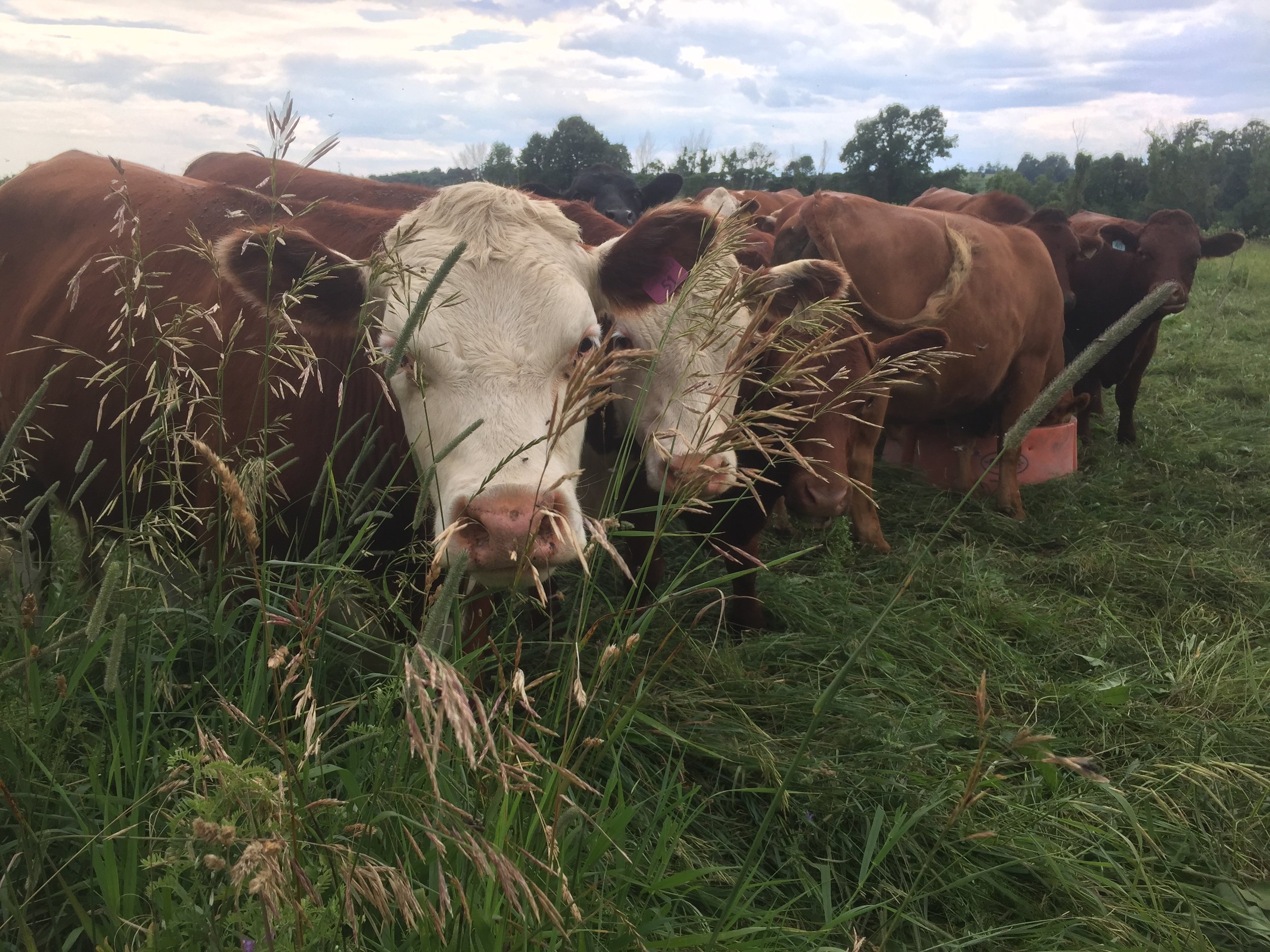
Growing Practices
We work alongside the plants, animals, and microorganisms on the farm as land stewards. Together we nurture a habitat that will sustain us and our community within the fabric of an intact and thriving ecosystem. In this, we are collaborative partners in landscape regeneration. Our collective impact builds soil, regulates water flow, and invites back biodiversity of all kinds across the surrounding gardens, pastures, woodlands, forests, and wetlands.
Our animal husbandry practices are guided by the animals and the landscape as we work to steward closed herds that become increasingly indigenous to this land. To do so, the animals are born into and cared for within multi-generational families, while the surrounding ecology informs our management and breeding practices. We select for animals whose shape and size do well on our clay soils (think less pounds per square inch of hoof pressure to alleviate compaction), who can forage their dietary needs from the land’s pasture species and medicinal hedgerows (our animals exhibit thriftiness and fatten well with no or limited need for supplemental feed), who have strong mothering instincts (our grandma-centric herds mentor the next generation building ancestral knowledge of foods, medicines, and behavior patterns), and friendly personalities towards humans.
We work with these animals to pattern a lifeway after their ancestors, and trust them to shape and regenerate their own habitat as we do ours. We prioritize their health and vibrancy, as they live full lives regenerating the land and also provide us with nutritious and delicious meats, beautiful and supple hides, and nutrient-rich compost.







Central to our work restoring the health of the land is our progress towards complete habitats that includes the food, shelter, fibers, and medicines to fully support communities. As our work continues, the land looks less and less like a traditional farm and more like an integrated mosaic of wetland, savanna, woodland, and forest ecosystems woven by a diversity and abundance of annual, perennial, tree, animal and human(animal) communities.
Cattle
Our herbivore cattle are 100% grass-fed, using adaptive mob-grazing practices that mimic their natural grazing and migration patterns - moving 1 to 8 times a day at 25,000 - 500,000 pounds per acre across the land May through December. The speed, rhythm, and intensity of moves are dictated by daily weather and seasonal climate, plant growth stage and productivity, the herd’s nutritional and medicinal needs, and our personal time availability. Calves are born on pasture in June through July to align peak nutritional needs of the lactating mama cows with the nutritional flush of summer pasture growth. Similarly, breeding season occurs in September through October at the annual peak of herd fertility. During deep winter and mud seasons, our cattle are fed organic hay from local farms, and live in a woodchip bedded pack system that allows us to make excellent fungi-rich compost from their winter manure.
Throughout the year, our cattle have access to free-choice minerals like selenium that is otherwise unavailable from our soils, kelp for iodine and salt because while wild herds may have visited the coast our herds do not, and biochar for gut health and soil restoration. We are always working to evolve our cattle habitat and management systems. In additional to improving water and fencing systems, we aspire to extend their grazing season further into the winter months through expanding our land base to allow for more stockpiling of summer forages, and growing trees and shrubs for nutrient-dense leaf forage and shelter from the wind. Winter grazing also benefits us financially by limiting our purchased hay expense and time expense managing our winter bedded pack system.
Pigs
Our omnivore pigs also move across the land, and forage much of their food from the pastures and woodlands. For now, a significant portion of their diet comes from organic, non-GMO, soy-free Vermont-grown grains as well as fruit, vegetable, and nut gleanings from neighbors and local farms and processors. We are working to grow more of their food and shelter habitat on our land by planting and regenerating fruit and nut trees and shrubs.
Veggies
We grow most of our vegetables in three unheated hoop houses, which allow us to grow year round, even through the coldest of Vermont winters. All of our vegetables are certified organic, which means that we never use synthetic fertilizers or chemicals. We also work at a small enough scale to be able to do all of our labor by hand, working to grow vegetables with as little soil disturbance as possible, with the goal of developing a full no-till production model both within our hoops and our outdoor gardens.
In doing this we are working to build a resilient and intact soil ecology that benefits both the land and the vegetables that are grown here. This is a system that often takes time to establish, but, among other things, leads to decreased soil erosion, decreased soil compaction, accumulation of organic matter and better water infiltration in the soil.
In spring 2017 we expanded our vegetable production into our first outdoor garden, which we created by sheet mulching (adding many layers of) composted soil and wood chips onto part of our home pasture. This outdoor garden, laid out according to a Keyline pattern, has a lot of organic matter and woody material which helps it to regulate moisture and provide nutrients to the growing plants. We began by planting vegetables in this garden and will transition to perennials and fruit and nut trees as the soil ecology becomes more ideal for these longer lived plants. In the coming years, we plan to expand these outdoor Keyline gardens to weave through our fields and integrate annual, perennial, and animal systems. We are always learning and experimenting and love this opportunity to garden outside with different vegetables in a different environment.





